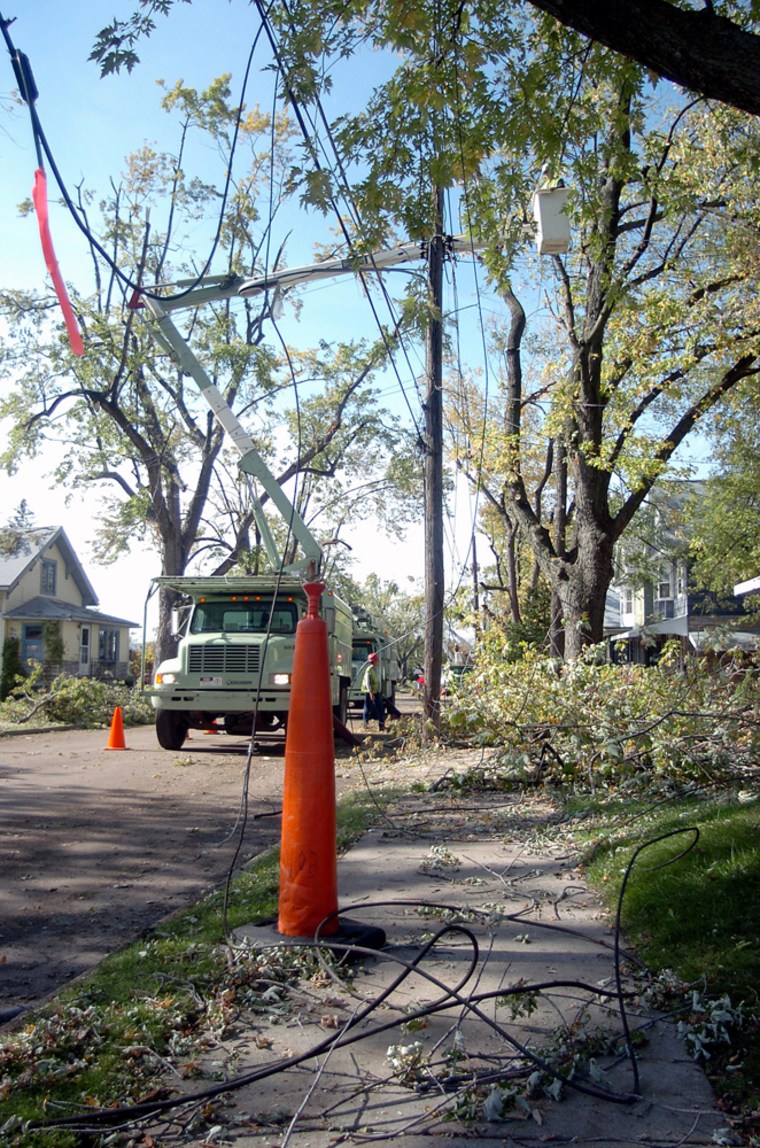With round-the-clock cleanup efforts continuing, about 101,500 homes and businesses remained without power Wednesday and schools in Buffalo and surrounding towns said they would be unable to reopen until next week.
U.S. Rep. Brian Higgins criticized the Federal Emergency Management Agency’s response as inadequate, saying the agency had offered little guidance on reimbursement and loan programs and snubbed the city of Buffalo during a tour of damage this week.
FEMA officials defended their response, saying they had readied generators and other equipment even before a Sunday disaster declaration that made up to $5 million in cleanup funds immediately available.
Tuesday marked day six without electricity for 85-year-old Helene Lipman, and the water in her basement had crept to the first step, so she moved into a Red Cross shelter at an elementary school.
Lipman said there had been some laughs at shelter, but with her power likely out through the coming weekend, the sense of adventure was wearing thin.
“Absolutely fed up,” she said when asked how she was faring. “I’m going to lose my furnace, washer, dryer.”
Six deaths
Three deaths have been blamed on carbon-monoxide poisoning from a generator. Three others died earlier in the storm, which dumped up to two feet of snow on Buffalo and the surrounding area last Thursday and Friday.
Some community warming centers were still filled to capacity, Mayor Byron Brown said. About 380,000 people originally lost power in the storm.
Most schools canceled classes Monday, and several large districts announced they would remain closed all week. In Buffalo, 21 school buildings were without electricity, while other districts worried buses would be unable to get down blocked streets.
National Grid spokesman Alberto Bianchetti said crews from 10 states and Canada were involved in the power restoration effort, working in 12- to 16-hour shifts.
"This is certainly a storm and restoration effort that ranks among the most significant we've ever had," Bianchetti said.
About 150 National Guard troops were activated to help clean up an estimated 10 million tons of debris in Erie County, and Buffalo police has extra patrols on the street while businesses remain closed.
The city had 60 two-person crews working to remove debris, said Public Works Commissioner Joe Giambra. Two private contractors were expected to arrive Sunday with another 70 crews to help with the cleanup, he said.
Some could be in dark for a week
Hospitals, senior centers, water and sewage treatment plants and other key operations were being given priority as National Grid and New York State Electric & Gas crews continued round-the-clock efforts to restore power. Nevertheless, it could take up to a week to restore power to some individual homes in outlying areas, utility officials said.
NYSEG reported it still had 74,000 customers without power Sunday evening. National Grid said it had about 180,000 residential and commercial customers without power. Some 392,000 homes and businesses were left powerless in the storm's immediate aftermath, including about 70 percent of the city of Buffalo.
"It's one of those kinds of storms you got to see it to believe it," said Steve Brady, a spokesman for National Grid.
Colder air surprised experts
Tom Paone, a forecaster with the National Weather Service, said the storm surprised even weather forecasters, who at first predicted heavy rain, then just a few inches of snow. But lake-effect storms — caused by cold northern winds blowing across the warmer Great Lakes — are notorious for unpredictability.
"What happened was that the air behind the cold front was colder than the models indicated. There also was a strong jet stream across New York that lifted the air, and made it even colder. Unfortunately, things came together at the right time in the right way," Paone said.
"We kept updating our forecasts, but even if we had put out information that this was going to happen, I'm not sure people would have believed us. There was no way to anticipate the widespread effect," he said.
